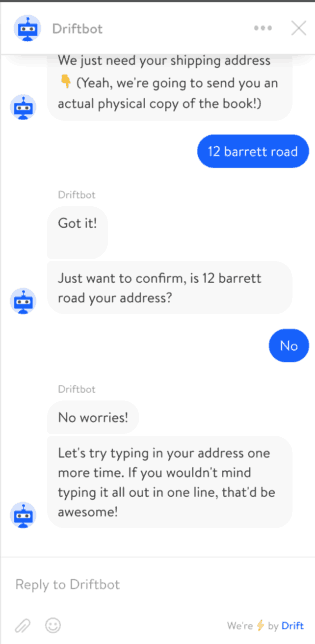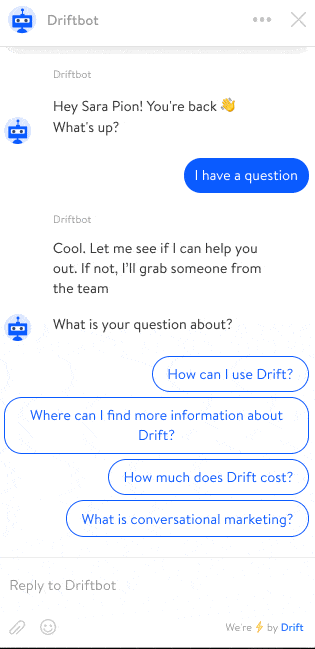
Up until 6 months ago, I had been working as a Drift customer advocate, supporting our customers and learning every detail about how our product worked.
That’s when our VP of Marketing Dave Gerhardt slacked me asking if I wanted to join the marketing team to run Drift (our product) for their team.
My new job would be to manage inbound traffic, and work to convert more traffic into leads using Drift chatbots.
But I had never done marketing before.
I’m always up for a challenge!
When I first started, we had about 50 Playbooks (bots, welcome messages, blog subscription callouts, and other campaigns you can run with Drift) running in our app, on our blog and on our marketing site.
Truthfully, the marketing team’s intention was to be constantly experimenting with our bots, giving them daily attention and unpacking all their potential with the latest features our product team was shipping. But they hadn’t spent as much time as they’d liked lately, which is why they asked for my help.
After taking a deeper dive into those 50 Playbooks, it was clear that there was a lot of room for improvement. The copy hadn’t been tested or changed in a while, the targeting could have been more personalized, and we weren’t very organized about where our bots appeared across on our site.
We were pretty much starting at the basic level of what Drift could do. Perfect. So I rolled up my sleeves, and I’ve been… busy.
When I started, I had a lot of big ideas. I was ready to mix things up. But admittedly, I didn’t have all the answers. But that’s the great thing about marketing: when you test something and it doesn’t have the results you wanted, you still learn and get smarter with your marketing.
Over the last six months I’ve been working with the rest of the marketing team, with our sales team and customer success team to create amazing experiences for our customers and future customers on drift.com.
Today, we have over 130 different Playbooks targeted to different people, at different times, appearing in different places on our site. They are all driving conversations with future customers, existing customers, even with lost customers.
How did we get here? Great question 🙂
Here are six lessons that I learned after six months of running Drift on Drift.
1. Iterate, iterate, iterate
As I was getting more and more comfortable being in a marketing role, I started running more experiments on our website.
It’s always scary to push something live onto your website and immediately see it do something you didn’t expect. Not everything worked, but that’s okay. I learned, and while I was learning, Drift was learning too. What I learned is that this entire process is iterative.
There isn’t a week that goes by where I don’t try something new on our website, monitor the results, and make further adjustments.
And while Drift has helped thousands of customers increase their website conversion, find higher quality leads and grow more sales pipeline – those customers didn’t become as successful as they did just because they bought Drift and turned it on. They worked for it.
Just like everything in marketing, you have to iterate and find out what works best for your business. With a little attention, it’s amazing how much progress you can make.
2. Innovate, don’t invent. Especially when it comes to copywriting.
Words matter, and one of the biggest challenges I first came across was coming up with fresh copy to add to our bots to make them more engaging.
But then it hit me: My team has created a website full of approved copy that they know works. Why don’t I just start with that?
And when I talk to our customers today, that’s what I tell them.
Writing for Bots is not very different than writing great email copy or your best sales rep asking discovery questions with a prospect.
You already have your best copy. You just need to find it.
If you’re doubting where to start, go sit with your sales reps and listen in on their calls. Ask to dig into emails they send, and look at their presentation decks. The words are likely all there for you already.
You don’t need to reinvent the wheel when it comes to copy for your bots.
3. Know that it’s ok if you have no idea what you’re doing
I think the coolest thing about being part of the conversational marketing movement is that it’s a new and constantly evolving approach to marketing.
We’re in the early days still, so if you’re participating, that means you’re also helping write the playbook.
We’ve discovered some things that worked really well for the bots on Drift’s website, and actually created a dip in results on a customers’ site. We’ve learned that there are very few “silver bullet” bots. That’s why it’s best to start simple and let them evolve naturally based on what your customers try to do with them.
If a site visitor chats in letting you know that they got hung up with a dead end in your bot, your bot’s message is worded in a way that’s hard to read (it happens to me all the time) or your sales team sends you an example where someone booked a time on their calendar, but weren’t actually qualified, don’t take it personally. That’s what is so great about this medium, people will give you positive constructive feedback. Just thank them and hop into the bot and make the necessary changes.
The best part about this entire process is that feedback comes fast and it comes often. Don’t be turned off by one negative conversation, use those learnings to make your bot better.
4. If you’re going to fail, fail gracefully
The whole reason that we have bots is better connect with the people on our site through conversations and eventually earn them as a customer. Bots do facilitate that conversation, but you can never anticipate everything someone will say on your site.
So instead of trying to set up intelligent keyword logic for every new question that came onto our site, I preplan that we won’t know everything and let our bot fail gracefully and offer up options conversationally. Here are some examples:


Drift bots are built by YOU, not by AI. You do not need to have the answer to every single question that someone may have when they come onto your site. (although we do have Drift Help for intelligently recognizing support questions.)
Instead, you can dictate how the conversation starts and proactively start the conversation. When it comes to more FAQ-type bots, make your button responses the questions that are asked the most. If someone types outside of your buttons, just make sure your bot has a response, no matter what. This is simple to do with a few clicks and it makes all the difference in the world.
5. You’ve done this before
You’ve written an email before right? Every great email is written with three things in mind. The subject line drives people to open it, the body is the conversation you are having with the recipient, which leads toward the call-to-action: what you really want you recipient to do.
We can use this formula to “prospect” site visitors with bots. When you’re building a prospecting (or really any) bot for your company, think of it as writing an email.
The subject line is your opening bot question.
You want people to click on it so they can see what’s inside. So make your first question engaging, start the conversation off the way YOU want to have the conversation, rather than passively.
Our best performing bots start off by asking if we can ask the site visitor a question. That way we can dictate how the flow goes, rather than the other way around.
The body of your email are your questions within the bot.
What makes you special, why should people care, what is your value proposition? Those should all be included in your bot conversation. The best part about conversational marketing is you can tell your prospects how amazing you are in seconds, rather than minutes or days. Make it count.
The call-to-action is what you want your site visitors to do.
Do you want them to book a meeting? Make it sound like the best option for them. If they say no to something you offer, counter offer. Maybe they want to watch a video demo. It’s a smaller ask and you can still ask the user for their email at the end.
We can sometimes overcomplicate things. Learning to start with this formula has served me really well.
Pro tip:
When people are on your website, there is a very good chance that they will be “Just Browsing” your site. Don’t add that as a button response in your bot and then write those people off as a bad lead.
You’re missing out on the opportunity to ask those people good prospecting questions that might actually get them ready to book a meeting or give their email.
6. Keep the conversation going
Once you feel like you’ve locked down your prospecting bots on your site, it’s time to start branching out!
The most fun bots that we have running aren’t the bots that book demos for our sales team, they’re the ones that can register people for our webinar in 1 click, or can tell them exactly how much ROI we can make them, or allow them to see what Drift would look like on their site without installing anything.
These are all extreme examples but chatbots allow you to open the floodgates when it comes to switching up your marketing strategy. Don’t gate content with a form, see if you can ask the same questions through a bot. Speaking at an event? Target the people on your site coming in from that state or country and tell them you want to hang out with them! Capture their email so you can give them an exclusive look at what you’ll be doing at that event. TALK to people.
Final Thought:
These tips are all well and good, but what kinds of results have we seen?
26 never before invented playbooks since February 2018: We’ve created 26 new playbooks since February 2018 including playbooks that: target existing customers, returning visitors, visitors coming in from different countries, visitors viewing certain landing pages, and automate our Account Based Marketing strategy.
Reached my personal goal of 1,500 net new bot-booked meetings way before I thought I would: This particular statistic increase in meetings is does not include increases via specialized collaborations with our growth team which account for a whole lot more. Fastlane, Powered-by, demo, pricing)
32% of Conversation Qualified Leads (CQLs) turn into sales opportunities. CQLs are hands down Drift’s best leads in terms of qualified leads to opportunities.
What’s next for me? More testing, More learning, More sharing. See you later, team.




